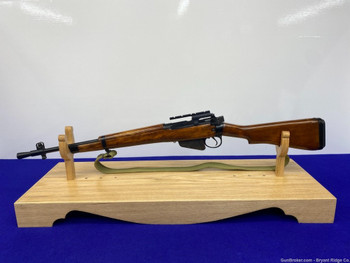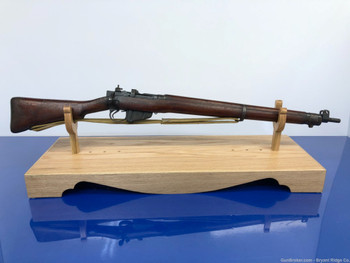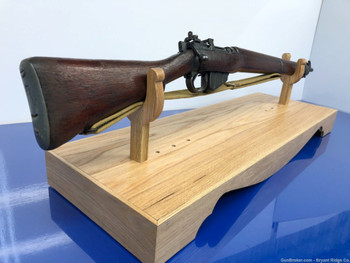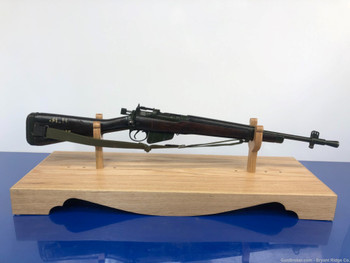Description
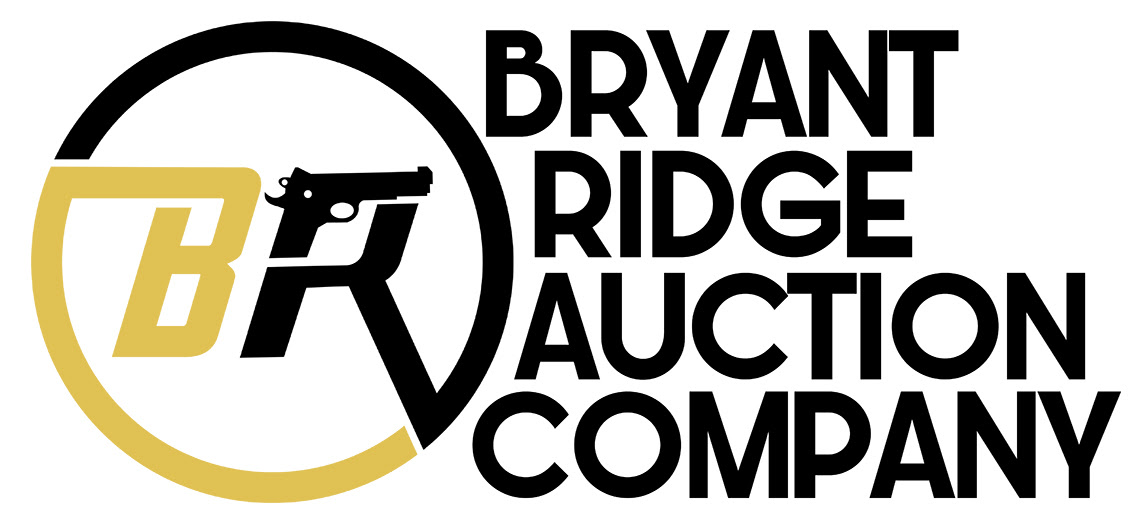
Item Description
This specific example is made to look like a derivative of the British Lee–Enfield No. 4 Mk I, the Rifle No. 5 Mk I, nicknamed the "Jungle Carbine." It features an 18.75" barrel with a coned flash hider and shorter stock.
Click here to view our other Live Auctions!
If you have missed out on this auction or are looking for a particular firearm, contact us. We have 100s of Collector Grade firearms (not on auction) in our inventory and available for immediate purchase.
Click here to let us know what firearms you are searching for!
Model: Enfield No. 4 MKI*
Serial: 77C0636
Caliber: .303 British
Finish: Blue
Barrel Length: 18.75" with Cone Flash hider
Optics/Sights: Wing Protected Blade Front with Adjustable Folding Aperture Rear
Stock/Grips: Smooth Wood
Action: Bolt
Markings: The left side of the receiver is stamped "U.S. PROPERTY" and "S No. 4 MKI*."
Bryant Ridge's Analysis:
The Remington Arms Company manufactured the rifles at their Illion, New York, and Eddystone, Pennsylvania factories. John Thompson of Thompson Submachine Gun fame was instrumental in establishing Remington’s Eddystone facility for producing the P14 rifle. Winchester manufactured the .303 P14 at their Connecticut plant. As the United States entered WWI in 1917, its 1903 “Springfield” rifle faced a shortage. To get rifles into the hands of US troops in the most expeditious manner possible, the .303 Pattern 14 Enfield was redesigned to utilize the standard US 30’06 cartridge. The decision was made to convert the Pattern 14 British rifle rather than re-tool the plant to manufacture the standard issue US 1903 design. The redesigned Enfield rifle was designated the U.S. Rifle Caliber .30 Model of 1917 and was the most prolific U.S.-issued weapon of the war.
World War Two began suddenly on the morning of September 1, 1939, when German forces invaded Poland. Two days later, on September 3, 1939, Great Britain and France both declared war on Germany. Within a matter of weeks, Poland was defeated. Although Great Britain and France had declared war on Germany, neither country could immediately mount any effective offensive against the fast-moving German Wehrmacht. By June of 1940 France capitulated leaving Great Britain virtually standing alone against Germany.
After declaring war, Great Britain again found itself in a dire situation, facing a German invasion of her homeland and desperately needing small arms to defend it. In 1940, they again turned to the industrial might of the United States, this time to manufacture the British-designed, bolt action Enfield No. 4 Mark I .303 caliber rifle. The J. Stevens Company was selected to manufacture the weapon. The Stevens Company was a division of the Savage Arms Company, and the rifles are often referred to as the “Savage Enfield” but were manufactured at the J. Stevens Arms Company River Plant in Chicopee, Massachusetts. Savage also manufactured the 1928 Model of the Thompson Submachine Gun for the Auto-Ordnance Corporation during that period. The J. Stevens Division assisted Savage in the manufacture of several Thompson parts.
Before the United States entered the Second World War in December of 1941, many Americans wanted the U.S. to stay out of the conflict. The tragedies and suffering of WWI were still fresh in their minds, and most felt the United States had no business getting involved in another “European” war. In the mid-1930s, the Neutrality Act was passed, which prohibited U.S. companies from selling weapons or any type of war material to foreign nations at war. The act was amended in September of 1939 to allow selling war goods on a strictly “cash and carry” basis to keep the U.S. from being financially involved in the war. On December 17, 1940, British Prime Minister Winston Churchill informed U.S. President Roosevelt that Britain would soon run out of the financial resources necessary to procure weapons and supplies under the “cash and carry” program.
Early in 1941, President Roosevelt realized that the U.S. needed to provide Great Britain with the weapons and supplies necessary to stave off the Germans while the U.S. Army prepared for an inevitable war. Winston Churchill told the United States, “Give us the tools, and we shall finish the job,” in a desperate plea for help. The Lend-Lease Act was passed in March of 1941. Under the Lend-Lease Act, the United States was to take over all British contracts with U.S. manufacturers. This included the Auto-Ordnance Thompson contracts and the Savage-Stevens contract for the Enfield rifle. (Auto-Ordnance subcontracted Savage for the manufacture of the Thompson.) One of the provisions of the Lend-Lease was that all weapons provided under the program should be U.S.-marked to show that the weapons, although being sent to allied nations, were the property of the United States. Consequently, subsequent Enfield rifles produced at Savage-Stevens were roll-marked U.S. PROPERTY on the receiver. Other parts were stamped with the distinctive Stevens squared S mark.
Savage-Stevens manufactured several thousand Enfield rifles under British contracts before the enactment of the Lend-Lease agreement. The early rifles made under direct British contract were not stamped with the US property marks commonly seen on later rifles. Soon after initial production began, the No. 4 MK I rifle was simplified for faster production. The major change was the elimination of the bolt release catch. This eliminated several parts of the weapon. The redesigned rifle was now designated as the No. 4 MK I * (Pronounced the Number four, Mark one, star), and represented the majority of Savage-Stevens Enfield production.
The WWII British No.4 MK I* evolved from a long line of Lee-Enfield rifles that were first adopted by the British Army in 1895. It was preceded and accompanied in WWII service by the equally famous No.1 MK III rifle of WWI fame. The No.5 “Jungle Carbine” was a lighter, shortened version of the Enfield rifle introduced in late 1944. Although quite compact and equipped with a flash-hider, the recoil and muzzle flash were excessive, and the rifle was not well-liked. The Enfield rifles also saw service and were manufactured in many of Great Britain’s Commonwealth nations. Like the Savage-produced Thompsons, the Savage-Stevens Enfield rifles had their receivers finished by the black oxide Dulite process, and the barrels were blued. The unique butt plate was made from a zinc alloy, rather than the brass or steel butt plates commonly fitted on Enfields. The J. Stevens Company manufactured receivers, bolts, trigger guards, bolt heads, and stocks; other parts were subcontracted. In addition to their S markings, the Savage Stevens Enfields can be identified by the letter C in their serial numbers. The C designates Chicopee, the location of the manufacturing plant. Most Enfield rifles manufactured by Savage-Stevens have U.S. PROPERTY stamped on the left side of the receiver, along with the Ordnance Department’s “Flaming Bomb” acceptance stamp. Early rifles were equipped with the ladder-type of adjustable rear sight, but these were soon replaced by the less complicated MK2, “L” style sight that could be flipped for a range of 300 or 600 yards.
Return Policy:
We gladly offer a 3 day unfired inspection policy from the time that the firearm is delivered to your FFL. Refunds are available for all qualifying orders.
Shipping Details
Handgun Standard Shipping $50.00
Long Gun Standard Shipping $70.00
We strive to ship orders within the close of the following business day after payment and documentation is received.
Payment Details
We accept all forms of Payment including Personal Check, Business Check, PO Money Orders, Certified Check, Etc.
Please note we place a 7 business day hold on shipment, for all non-certified payments.
Payment MUST be received within 14 days.
Return Policy
We gladly offer a 3 day unfired inspection policy from the time that the firearm is delivered to your FFL. Refunds are available for all qualifying orders.
Additional Details
Our #1 priority is customer satisfaction. We want to build a lasting trust in the relationship with our customers, so that you will always look to us for all your firearms needs. If you have any issues with your transactions please contact us, and we will work with you to resolve any issues you may have. We greatly appreciate your trust in us and we look forward to fulfilling all your future firearm needs.
Bryant Ridge also reserves the right to cancel any sales that may occur while gunbroker.com is experiencing technical issues that affects the entire site or a complete site outage, within an hour of the auction ending.
We have an amazing inventory of classic and collector firearms that we are adding to Gunbroker daily. Stay up to date on all of our latest auction by adding us to your favorite sellers list.

About Us













